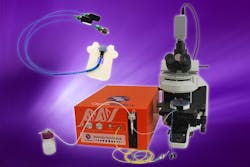Optofluidics chooses Avo Photonics to produce molecular tweezer system
Horsham, PA--Halma company Avo Photonics, specialists in optoelectronic systems requiring precision optical alignment, was chosen by Optofluidics (Philadelphia, PA) to provide system design and manufacturing services for Optofluidics' molecular NanoTweezer system. The optical tweezer system—called NanoTweezer—is made up of three components: a microscope flow system that sits atop the microscope platform, removable waveguide chips that are inserted into the flow system, and a benchtop control unit; the technology allows users to isolate objects more than 10 times smaller than those trapped by traditional optical tweezers.
Using a beam of light to capture nanoscale objects floated in fluid, such as individual cells, viruses, single bacteria, nucleic acids, metal nanoparticles, carbon nanotubes, and some proteins, optical tweezers provide a way for these particles to be studied and manipulated under a microscope. Conventional optical tweezers use lenses to focus the optical spot in the far-field, causing capturable particles to be restrained by the Rayleigh limit. The NanoTweezer uses photonic resonator chips to create a miniscule aperture in the near-field, allowing the beam to attract particles as small as 5 nm in size. The companies say that the 1060 nm wavelength laser beam causes no negative heating effects or other damage to biological objects. The ability to safely isolate and study particles of this size is critical for future advancements in physiology, medicine, and material science.
For this project, Avo provided the design and production of disposable assemblies consisting of three single-mode, polarization-maintaining fibers hard-coupled to a NanoTweezer chip that contains Optofluidics' waveguide technology. With a mode-field diameter of nine microns per fiber, and an even smaller aperture for the waveguide, the alignment of these two components required Avo's expertise for alignability, stability, and robustness while balancing the cost constraints associated with disposable materials.
Additionally, Avo created the means to tune the wavelength and control the power of the laser through the benchtop NanoTweezer system. Through manipulation of these settings, the wavelength of the laser can be tuned to a resonance in the waveguide to enhance the optical tweezing effect.
"This technology is a really cutting edge way of manipulating nanoscale objects, and Avo helped us realize our goals much more quickly than anticipated," says Robert Hart, CTO of Optofluidics.
Keith Forsyth, principal engineer of Avo Photonics, said, "Optofluidics is doing groundbreaking work. The ability to control the movement of ever-smaller objects with light is a critically important tool for many biological applications, now and in the future. We are excited to be a part of this development and look forward to volume production of NanoTweezer systems and disposable fiber-coupled waveguide chips."
Optofluidics has been developing microfluidic and biophotonic nanomanipulation technologies for biological, material science, and pharmaceutical applications since 2011. In 2012 Optofluidics was named Philadelphia Life Sciences startup of the year.
SOURCE: Avo Photonics via Halma; http://halmapr.com/news/avo-photonics/2013/09/10/avo-photonics-provides-design-and-production-services-for-optofluidics-nanotweezer-system/

Gail Overton | Senior Editor (2004-2020)
Gail has more than 30 years of engineering, marketing, product management, and editorial experience in the photonics and optical communications industry. Before joining the staff at Laser Focus World in 2004, she held many product management and product marketing roles in the fiber-optics industry, most notably at Hughes (El Segundo, CA), GTE Labs (Waltham, MA), Corning (Corning, NY), Photon Kinetics (Beaverton, OR), and Newport Corporation (Irvine, CA). During her marketing career, Gail published articles in WDM Solutions and Sensors magazine and traveled internationally to conduct product and sales training. Gail received her BS degree in physics, with an emphasis in optics, from San Diego State University in San Diego, CA in May 1986.
